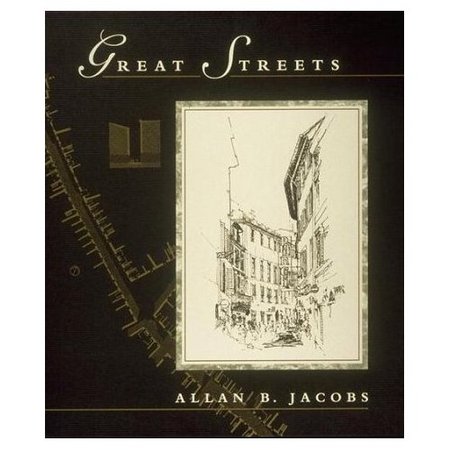May 08, 2009 Categories: Reviews
Great Streets
1993. MIT Press. 341 pp. $42 (paperback)
How much can good street design contribute to public life? Any book touching on this subject has to steer between claiming too much (physical determinism) and claiming too little (what’s the point?). Great Streets negotiates this passage with aplomb, while conveying information unavailable elsewhere and providing the allure of a coffee-table book.
Author Allan Jacobs acknowledges that social and economic conditions may be more important than physical design. He even quotes architect Dolf Schnebli to that effect: “A good urban street is always good in a context. Its goodness can change — if Hitler is in charge of the city, all streets are bad.” {7} But Jacobs insists that even if Schnebli is right, “Streets still have to be laid out and designed. … It does no good for someone faced with determining the width of a street, the sizes of walks, whether or not there should be trees or benches and where they should be placed, and a host of other possible considerations, to demur and to say that these considerations don’t much matter. Even if they didn’t much matter, the possibility that they might matter at all raises the question for better or for worse.” {6, 8}

Clearly Jacobs thinks physical design matters a lot — otherwise, why write a whole book on it? His main purpose is not to argue the generalities but to provide comparable information about great and almost-great streets for the use of those who are concerned with physical specifications.
Eighteen streets get the de luxe treatment in Part One, with written accounts — often rhapsodic — interlaced with illustrations and diagrams for Roslyn Place (Pittsburgh); Via dei Giubbonari, Via del Corso, and Viale delle Terme di Caracalla (Rome); Strøget (Copenhagen); Paseo de Gracia and The Ramblas (Barcelona); Cours Mirabeau (Aix-en-Provence); Avenue Montaigne, Boulevard Saint-Michel, and Avenue des Champs-Elysées (Paris); Market Street (San Francisco); Monument Avenue (Richmond); Richard Road (Mills College, Oakland, California); Beijing; Bath; and Bologna.
Part Two gives a more image-heavy, bullet-point treatment to 27 additional streets grouped by category: ancient, medieval, central, small-town, residential, tree, one-sided, and more. Every street has plan, section, sometimes even paving details.
Part Three takes a more elevated view, with fifty square-mile maps to the same scale of cities from Ahmedabad to Zurich. (Berlin and Zurich get comparative views from different years.) Jacobs observes that “the scale of older cities is generally much smaller and finer than that of newer cities,” which is something of an understatement. (It’s hard to believe that Venice and Midtown Manhattan are really to the same scale.) Another way to measure this change is the number of intersections: within the mapped square mile, Venice has over 1,500 intersections, lower Manhattan about 220, and Irvine, California, 15. “The newer is almost always simpler, more regular, larger-scaled. Even in a relatively new city, like Oakland, California, the original grid was smaller and more complex than the newer grid to the north.” And as the reader braces for a full-voice rant about the evils of the automobile, Jacobs acknowledges, “Largeness started well before the auto, as the patterns of New York and San Francisco will attest.” {259}
After all this detail, Jacobs returns to the big questions in Part Four. While you were enjoying the pictures, plans, sections, maps, and meditations on particular streets and places, he was taking notes. From them he distills eight requirements — necessary conditions for street greatness. None of these qualities, separately or together, guarantee greatness, but streets without them have no hope of it:
- places for people to walk with some leisure.
- physical comfort.
- definition, vertical and horizontal. This leaves plenty of room for variation, but “the height of buildings along the best streets is less than 100 feet.” This five-page discussion of human scale is the most technical material in the book, but likely the most rewarding for those who are ready for it.
- qualities that engage the eyes, notably visual complexity and movement. (Yet, streets with detailed facades can be monotonous too.)
- transparency, which usually (but not quite always!) means plenty of windows and doors.
- complementarity (buildings respecting each other).
- good maintenance — which often translates into the use of materials easy to maintain.
- quality construction and design (which need not be expensive).
The author goes on to list thirteen additional features that usually contribute to great streets, but aren’t absolute necessities: trees, beginnings and endings, many diverse buildings, special design features like streetlights and benches, “places” (small plazas or parks) along the way, accessibility, density of nearby population, diversity, length, slope, parking (most great streets have some but not enough by traffic-engineering standards), contrast, and time.
Writing in the early 90s, Jacobs addressed a final question: has technology made cities and their streets obsolete? Perhaps for some, he writes with characteristic restraint. But even so, “Cities would still be desirable for many people. We can build and live in cities because we want to, not because we have to but because they offer the prospect of a fulfilling gregarious life.” {314} So far so good, but bear in mind that cities of choice are almost guaranteed to be less diverse than were cities of necessity.
#
